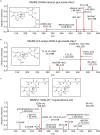Biotransformation of the mycotoxin deoxynivalenol in fusarium resistant and susceptible near isogenic wheat lines
- PMID: 25775425
- PMCID: PMC4361057
- DOI: 10.1371/journal.pone.0119656
Biotransformation of the mycotoxin deoxynivalenol in fusarium resistant and susceptible near isogenic wheat lines
Abstract
In this study, a total of nine different biotransformation products of the Fusarium mycotoxin deoxynivalenol (DON) formed in wheat during detoxification of the toxin are characterized by liquid chromatography-high resolution mass spectrometry (LC-HRMS). The detected metabolites suggest that DON is conjugated to endogenous metabolites via two major metabolism routes, namely 1) glucosylation (DON-3-glucoside, DON-di-hexoside, 15-acetyl-DON-3-glucoside, DON-malonylglucoside) and 2) glutathione conjugation (DON-S-glutathione, "DON-2H"-S-glutathione, DON-S-cysteinyl-glycine and DON-S-cysteine). Furthermore, conjugation of DON to a putative sugar alcohol (hexitol) was found. A molar mass balance for the cultivar 'Remus' treated with 1 mg DON revealed that under the test conditions approximately 15% of the added DON were transformed into DON-3-glucoside and another 19% were transformed to the remaining eight biotransformation products or irreversibly bound to the plant matrix. Additionally, metabolite abundance was monitored as a function of time for each DON derivative and was established for six DON treated wheat lines (1 mg/ear) differing in resistance quantitative trait loci (QTL) Fhb1 and/or Qfhs.ifa-5A. All cultivars carrying QTL Fhb1 showed similar metabolism kinetics: Formation of DON-Glc was faster, while DON-GSH production was less efficient compared to cultivars which lacked the resistance QTL Fhb1. Moreover, all wheat lines harboring Fhb1 showed significantly elevated D3G/DON abundance ratios.
Conflict of interest statement
Figures





Similar articles
-
The ability to detoxify the mycotoxin deoxynivalenol colocalizes with a major quantitative trait locus for Fusarium head blight resistance in wheat.Mol Plant Microbe Interact. 2005 Dec;18(12):1318-24. doi: 10.1094/MPMI-18-1318. Mol Plant Microbe Interact. 2005. PMID: 16478051
-
Components of the gene network associated with genotype-dependent response of wheat to the Fusarium mycotoxin deoxynivalenol.Funct Integr Genomics. 2008 Nov;8(4):421-7. doi: 10.1007/s10142-008-0089-4. Epub 2008 Jul 1. Funct Integr Genomics. 2008. PMID: 18592282
-
Mechanisms regulating grain contamination with trichothecenes translocated from the stem base of wheat (Triticum aestivum) infected with Fusarium culmorum.Phytopathology. 2013 Jul;103(7):682-9. doi: 10.1094/PHYTO-11-12-0296-R. Phytopathology. 2013. PMID: 23758328
-
Resistance in wheat to Fusarium infection and trichothecene formation.Toxicol Lett. 2004 Oct 10;153(1):37-46. doi: 10.1016/j.toxlet.2004.04.044. Toxicol Lett. 2004. PMID: 15342079 Review.
-
Deoxynivalenol: a major player in the multifaceted response of Fusarium to its environment.Toxins (Basel). 2013 Dec 19;6(1):1-19. doi: 10.3390/toxins6010001. Toxins (Basel). 2013. PMID: 24451843 Free PMC article. Review.
Cited by
-
Stable Isotope-Assisted Metabolomics for Deciphering Xenobiotic Metabolism in Mammalian Cell Culture.ACS Chem Biol. 2020 Apr 17;15(4):970-981. doi: 10.1021/acschembio.9b01016. Epub 2020 Mar 25. ACS Chem Biol. 2020. PMID: 32167285 Free PMC article.
-
Effect of Fungicide Treatment on Multi-Mycotoxin Occurrence in French Wheat during a 4-Year Period.Toxins (Basel). 2023 Jul 4;15(7):443. doi: 10.3390/toxins15070443. Toxins (Basel). 2023. PMID: 37505712 Free PMC article.
-
Towards the development of innovative multi-mycotoxin reference materials as promising metrological tool for emerging and regulated mycotoxin analyses.Mycotoxin Res. 2017 Feb;33(1):15-24. doi: 10.1007/s12550-016-0259-5. Epub 2016 Nov 4. Mycotoxin Res. 2017. PMID: 27815916
-
Stable Isotope-Assisted Plant Metabolomics: Investigation of Phenylalanine-Related Metabolic Response in Wheat Upon Treatment With the Fusarium Virulence Factor Deoxynivalenol.Front Plant Sci. 2019 Oct 30;10:1137. doi: 10.3389/fpls.2019.01137. eCollection 2019. Front Plant Sci. 2019. PMID: 31736983 Free PMC article.
-
Multiple Clonostachys rosea UDP-Glycosyltransferases Contribute to the Production of 15-Acetyl-Deoxynivalenol-3-O-Glycoside When Confronted with Fusarium graminearum.J Fungi (Basel). 2023 Jul 2;9(7):723. doi: 10.3390/jof9070723. J Fungi (Basel). 2023. PMID: 37504712 Free PMC article.
References
-
- Chakraborty S, Newton AC. Climate change, plant diseases and food security: an overview. Plant Pathol. 2011;60: 2–14.
Publication types
MeSH terms
Substances
LinkOut - more resources
Full Text Sources
Other Literature Sources

